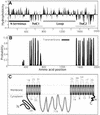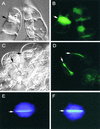A cell plate-specific callose synthase and its interaction with phragmoplastin
- PMID: 11283334
- PMCID: PMC135532
- DOI: 10.1105/tpc.13.4.755
A cell plate-specific callose synthase and its interaction with phragmoplastin
Abstract
Callose is synthesized on the forming cell plate and several other locations in the plant. We cloned an Arabidopsis cDNA encoding a callose synthase (CalS1) catalytic subunit. The CalS1 gene comprises 42 exons with 41 introns and is transcribed into a 6.0-kb mRNA. The deduced peptide, with an approximate molecular mass of 226 kD, showed sequence homology with the yeast 1,3-beta-glucan synthases and is distinct from plant cellulose synthases. CalS1 contains 16 predicted transmembrane helices with the N-terminal region and a large central loop facing the cytoplasm. CalS1 interacts with two cell plate--associated proteins, phragmoplastin and a novel UDP-glucose transferase that copurifies with the CalS complex. That CalS1 is a cell plate--specific enzyme is demonstrated by the observations that the green fluorescent protein--CalS1 fusion protein was localized at the growing cell plate, that expression of CalS1 in transgenic tobacco cells enhanced callose synthesis on the forming cell plate, and that these cell lines exhibited higher levels of CalS activity. These data also suggest that plant CalS may form a complex with UDP-glucose transferase to facilitate the transfer of substrate for callose synthesis.
Figures






Similar articles
-
A novel UDP-glucose transferase is part of the callose synthase complex and interacts with phragmoplastin at the forming cell plate.Plant Cell. 2001 Apr;13(4):769-79. doi: 10.1105/tpc.13.4.769. Plant Cell. 2001. PMID: 11283335 Free PMC article.
-
Plant callose synthase complexes.Plant Mol Biol. 2001 Dec;47(6):693-701. doi: 10.1023/a:1013679111111. Plant Mol Biol. 2001. PMID: 11785931 Review.
-
Expression of callose synthase genes and its connection with Npr1 signaling pathway during pathogen infection.Planta. 2008 Dec;229(1):87-98. doi: 10.1007/s00425-008-0812-3. Epub 2008 Sep 20. Planta. 2008. PMID: 18807070
-
A putative plant homolog of the yeast beta-1,3-glucan synthase subunit FKS1 from cotton (Gossypium hirsutum L.) fibers.Planta. 2001 Jun;213(2):223-30. doi: 10.1007/s004250000496. Planta. 2001. PMID: 11469587
-
Cellulose biosynthesis in plants: from genes to rosettes.Plant Cell Physiol. 2002 Dec;43(12):1407-20. doi: 10.1093/pcp/pcf164. Plant Cell Physiol. 2002. PMID: 12514238 Review.
Cited by
-
Poplar carbohydrate-active enzymes. Gene identification and expression analyses.Plant Physiol. 2006 Mar;140(3):946-62. doi: 10.1104/pp.105.072652. Epub 2006 Jan 13. Plant Physiol. 2006. PMID: 16415215 Free PMC article.
-
The transcription factor PbrbZIP52 positively affects pear pollen tube longevity by promoting callose synthesis.Plant Physiol. 2023 Mar 17;191(3):1734-1750. doi: 10.1093/plphys/kiad002. Plant Physiol. 2023. PMID: 36617219 Free PMC article.
-
Members of the Arabidopsis dynamin-like gene family, ADL1, are essential for plant cytokinesis and polarized cell growth.Plant Cell. 2003 Apr;15(4):899-913. doi: 10.1105/tpc.009670. Plant Cell. 2003. PMID: 12671086 Free PMC article.
-
Update on mechanisms of plant cell wall biosynthesis: how plants make cellulose and other (1->4)-β-D-glycans.Plant Physiol. 2011 Jan;155(1):171-84. doi: 10.1104/pp.110.163360. Epub 2010 Nov 4. Plant Physiol. 2011. PMID: 21051553 Free PMC article. Review. No abstract available.
-
The Arabidopsis CALLOSE DEFECTIVE MICROSPORE1 gene is required for male fertility through regulating callose metabolism during microsporogenesis.Plant Physiol. 2014 Apr;164(4):1893-904. doi: 10.1104/pp.113.233387. Epub 2014 Feb 24. Plant Physiol. 2014. PMID: 24567187 Free PMC article.
References
-
- Arioli, T., et al. (1998). Molecular analysis of cellulose biosynthesis in Arabidopsis. Science 279, 717–720. - PubMed
-
- Aspinall, G.O., and Kessler, G. (1957). The structure of callose from the grape vine. Chem. Ind. (London), p. 1296.
-
- Brown, R.M., Jr., Saxena, I.M., and Kudlicka, K. (1996). Cellulose biosynthesis in higher plants. Trends Plant Sci. 1, 149–156.
-
- Burge, C., and Karlin, S. (1997). Prediction of complete gene structures in human genomic DNA. J. Mol. Biol. 268, 78–94. - PubMed
Publication types
MeSH terms
Substances
LinkOut - more resources
Full Text Sources
Other Literature Sources
Molecular Biology Databases
Research Materials

